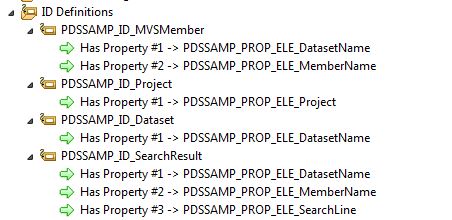Correct Usage of ID Definition
The ID definition in AWM uniquely identifies elements of a certain element type.
As a unique identifier, an ID definition should consist of the key properties that identify an element in the context of the application. AWM needs a value for each key property of the corresponding ID definition when it creates a new element. A run-time exception occurs if there is a missing key property value at creation time. Elements with identical key property values are considered as identical.
You should only define the exact number of properties in an ID definition of an element that are needed to uniquely identify the element type's elements. If not enough properties are defined, different elements of the application could be considered as the same element. If too many properties are defined, a single element with different values in the non-key properties is considered as two different elements.
- PDSSAMP_ID_MVSMember
- PDSSAMP_ID_Project
- PDSSAMP_ID_Dataset
- PDSSAMP_ID_SearchResult

The ID definition mappings to the PDS Explorer element types is as follows:
| ID Definition | Element Type(s) |
|---|---|
| PDSSAMP_ID_Project | PDSSAMP_ELE_Project |
| PDSSAMP_ID_Dataset | PDSSAMP_ELE_Dataset |
| PDSSAMP_ID_MVSMember | PDSSAMP_ELE_EDITABLE, PDSSAMP_ELE_NON-EDITABLE, PDSSAMP_ELE_UNKNOWN |
| PDSSAMP_ID_SearchResult | PDSSAMP_ELE_SEARCHRESULT |
The element types PDSSAMP_ELE_EDITABLE, PDSSAMP_ELE_NON-EDITABLE, and PDSSAMP_ELE_UNKNOWN share an ID definition. The mapping to the correct element type is done by the element type property which has to contain the match name defined for the corresponding element type.